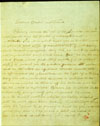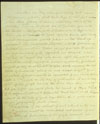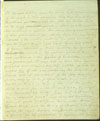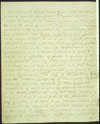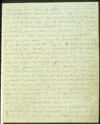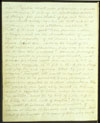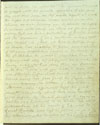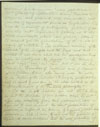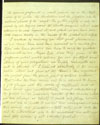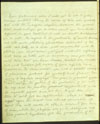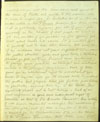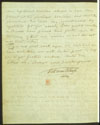Mahatma Letter No. 1: Difference between revisions
| Line 295: | Line 295: | ||
<br> | <br> | ||
<br> | <br> | ||
The Mahatma educates Sinnett about the value of leaving the public uncertain about occult matters. As he says in the pages 8-9, "The ignorant — unable to grapple with the invisible operators — might some day vent their rage on the visible agents at work; the higher and educated classes would go on disbelieving as ever, tearing you to shreds as before." A similar sentiment is expressed in [[Mahatma Letter No. 29]], that "so long as men doubt there will be curiosity and enquiry, and that enquiry stimulates | The Mahatma educates Sinnett about the value of leaving the public uncertain about occult matters. As he says in the pages 8-9, "The ignorant — unable to grapple with the invisible operators — might some day vent their rage on the visible agents at work; the higher and educated classes would go on disbelieving as ever, tearing you to shreds as before." A similar sentiment is expressed in [[Mahatma Letter No. 29]], that "so long as men doubt there will be curiosity and enquiry, and that enquiry stimulates reflection which begets effort."<ref>Joy Mills, ''Reflections on an Ageless Wisdom'', Wheaton, IL: Theosophical Publishing House, 2010), 4-5.</ref> | ||
<br> | <br> | ||
<br> | <br> | ||
Sinnett had not adequately considered the likely consequences of producing indisputable phenomena. Joy Mills reinforces this point by quoting a letter from Koot Hoomi to [[W. T. Brown]] in 1883 that the results from a public demonstration of phenomena would be "disastrous."<ref>Joy Mills, 5-6. The Brown letter was published in ''Letters from the Masters of the Wisdom'', First Series.</ref> | Sinnett had not adequately considered the likely consequences of producing indisputable phenomena. Joy Mills reinforces this point by quoting a '''[[Mahatma Letter to W T Brown - LMW 1 No. 22|letter from Koot Hoomi]]''' to [[W. T. Brown]] in 1883 that the results from a public demonstration of phenomena would be "disastrous."<ref>Joy Mills, 5-6. The Brown letter was published in ''Letters from the Masters of the Wisdom'', First Series.</ref> | ||
<br> | <br> | ||
<br> | <br> | ||
Revision as of 15:55, 15 October 2019
| Quick Facts | |
|---|---|
| People involved | |
| Written by: | Koot Hoomi |
| Received by: | A. P. Sinnett |
| Sent via: | unknown |
| Dates | |
| Written on: | October 15, 1880 |
| Received on: | October 17 (or 18 per BdZ) |
| Other dates: | none |
| Places | |
| Sent from: | Toling Monastery, Tibet |
| Received at: | Simla, India |
| Via: | none |
This is Letter No. 1 in Barker numbering. In it, Koot Hoomi responds to A. P. Sinnett's idea that the existence of the Mahatmas could be proved to skeptics by simultaneously having a London newspaper precipated in India on the very day of its publication, and a Pioneer precipitated in London. KH explains why that method would not work. See below for Context and background.
Next letter chrono >
Next letter Barker >
Page 1 transcription, image, and notes
|
Received Simla about October 15th, 1880. Esteemed Brother and Friend, Precisely because the test of the London newspaper would close the mouths of the skeptics — it is unthinkable. See it in what light you will — the world is yet in its first stage of disenthralment if not development, hence — unprepared. Very true, we work by natural not supernatural means and laws. But, as on the one hand Science would find itself unable (in its present state) to account for the wonders given in its name, and on the other the ignorant masses would still be left to view the phenomenon in the light of a miracle; everyone who would thus be made a witness to the occurrence would be thrown off his balance and the results would be deplorable. Believe me, it would be so — especially for yourself who originated the idea, and the devoted woman who so foolishly rushes into the wide open door leading to notoriety. This door, though opened by so friendly a hand as yours, would prove very soon a trap — and a fatal one indeed for her. And such is not surely your object? |
|
NOTES:
|
Page 2
|
Madmen are they, who, speculating but upon the present, wilfully shut their eyes to the past when made already to remain naturally blind to the future! Far be it from me, to number you with the latter — therefore will I endeavour to explain. Were we to accede to your desires know you really what consequences would follow in the trail of success? The inexorable shadow which follows all human innovations moves on, yet few are they, who are ever conscious of its approach and dangers. What are then to expect they, who would offer the world an innovation which, owing to human ignorance, if believed in, will surely be attributed to those dark agencies the two-thirds of humanity believe in and dread as yet? You say — half London would be converted if you could deliver them a Pioneer on its day of publication. I beg to say that if the people believed the thing true they would kill you before you could make the round of Hyde Park; if it were not believed true, — the least that could happen would be the loss of your reputation and good name, — for propagating such ideas. The success of an attempt of such a kind as the one you propose, must be calculated and based upon a thorough knowledge of the people around you. |
|
NOTES: |
Page 3
|
It depends entirely upon the social and moral conditions of the people in their bearing on these deepest and most mysterious questions which can stir the human mind — the deific powers in man and the possibilities contained in nature. How many, even of your best friends, of those who surround you, who are more than superficially interested in these abstruse problems? You could count them upon the fingers of your right hand. Your race boasts of having liberated in their century, the genius so long imprisoned in the narrow vase of dogmatism and intolerance — the genius of knowledge, wisdom and freethought. It says that in their turn ignorant prejudice and religious bigotry, bottled up like the wicked Jin of old, and sealed up by the Solomons of science rests at the bottom of the sea and can never, escaping to the surface again, reign over the world as it did in days of old; that the public mind is quite free, in short, and ready to accept any demonstrated truth. Aye; but is it verily so, my respected friend? Experimental knowledge does not quite date from 1662, when Bacon, Robert Boyle and the Bishop of Chester transformed under the royal charter their "Invisible College" into a Society for the promotion of experimental science. |
|
NOTES:
|
Page 4
|
Ages before the Royal Society found itself becoming a reality upon the plan of the "Prophetic Scheme" an innate longing for the hidden, a passionate love for and the study of nature had led men in every generation to try and fathom her secrets deeper than their neighbours did. Roma ante Romulum fuit — is an axiom taught to us in your English schools. Abstract enquiries into the most puzzling problems did not arise in the brain of Archimedes as a spontaneous and hitherto untouched subject, but rather as a reflection of prior enquiries in the same direction and by men separated from his days by as long a period — and far longer — than the one which separates you from the great Syracusian. The vril of the "Coming Race" was the common property of races now extinct. And, as the very existence of those gigantic ancestors of ours is now questioned — though in the Himavats, on the very territory belonging to you we have a cave full of the skeletons of these giants — and their huge frames when found are invariably regarded as isolated freaks of nature, so the vril or Akas — as we call it — is looked upon as an impossibility, a myth. And, without a |
|
NOTES:
|
Page 5
|
thorough knowledge of Akas, its combinations and properties, how can Science hope to account for such phenomena? We doubt not but the men of your science are open to conviction; yet facts must be first demonstrated to them, they must first have become their own property, have proved amenable to their own modes of investigation, before you find them ready to admit them as facts. If you but look into the Preface to the "Micrographia" you will find in Hooke's suggestions that the intimate relations of objects were of less account in his eyes than their external operation on the senses — and Newton's fine discoveries found in him their greatest opponent. The modern Hookeses are many. Like this learned but ignorant man of old your modern men of science are less anxious to suggest a physical connexion of facts which might unlock for them many an occult force in nature, as to provide a convenient "classification of scientific experiments"; so that the most essential quality of an hypothesis is not that it should be true but only plausible — in their opinion. So far for Science — as much as we know of it. As for human nature in general, it is the same now as it was a million of years |
|
NOTES:
|
Page 6
|
ago: Prejudice based upon selfishness; a general unwillingness to give up an established order of things for new modes of life and thought — and occult study requires all that and much more —; pride and stubborn resistance to Truth if it but upsets their previous notions of things, — such are the characteristics of your age, and especially of the middle and lower classes. What then would be the results of the most astounding phenomena, supposing we consented to have them produced? However successful, danger would be growing proportionately with success. No choice would soon remain but to go on, ever crescendo, or to fall in this endless struggle with prejudice and ignorance killed by your own weapons. Test after test would be required and would have to be furnished; every subsequent phenomenon expected to be more marvellous than the preceding one. Your daily remark is, that one cannot be expected to believe unless he becomes an eye-witness. Would the lifetime of a man suffice to satisfy the whole world of skeptics? It may be an easy matter to increase the original number of believers at Simla to hundreds and thousands. But what of the hundreds of millions of those who could |
NOTES: |
Page 7
|
not be made eye-witnesses? The ignorant — unable to grapple with the invisible operators — might some day vent their rage on the visible agents at work; the higher and educated classes would go on disbelieving as ever, tearing you to shreds as before. In common with many, you blame us for our great secrecy. Yet we know something of human nature for the experience of long centuries — aye, ages — has taught us. And, we know, that so long as science has anything to learn, and a shadow of religious dogmatism lingers in the hearts of the multitudes, the world's prejudices have to be conquered step by step, not at a rush. As hoary antiquity had more than one Socrates so the dim Future will give birth to more than one martyr. Enfranchised science contemptuously turned away her face from the Copernican opinion renewing the theories of Aristarchus Samius — who "affirmeth that the earth moveth circularly about her own centre" years before the Church sought to sacrifice Galileo as a holocaust to the Bible. The ablest mathematician at the Court of Edward VI — Robert Recorde — was left to starve in jail by his colleagues, who laughed at his Castle of Knowledge, |
|
NOTES:
|
Page 8
|
declaring his discoveries "vain phantasies." Wm. Gilbert of Colchester — Queen Elisabeth's physician — died poisoned, only because — this real founder of experimental science in England — has had the audacity of anticipating Galileo; of pointing out Copernican's fallacy as to the "third movement," which was gravely alleged to account for the parallelism of the earth's axis of rotation! The enormous learning of the Paracelsi, of the Agrippas and the Deys was ever doubted. It was science which laid her sacrilegious hand upon the great work "De Magnete" — "The Heavenly White Virgin" (Akas) and others. And it was the illustrious "Chancellor of England and of Nature" — Lord Verulam-Bacon — who having won the name of the Father of Inductive Philosophy, permitted himself to speak of such men as the above-named as the "Alchemicians of the Fantastic philosophy." All this is old history, you will think. Verily so; but the chronicles of our modern days do not differ very essentially from their predecessors. And we have but to bear in mind the recent persecutions of mediums in England, the burning of supposed witches, and sorcerers in South America, Russia and the frontiers of Spain — to assure ourselves that the only salvation of |
|
NOTES:
|
Page 9
|
the genuine proficients in occult sciences lies in the skepticism of the public: the charlatans and the jugglers are the natural shields of the "adepts." The public safety is only ensured by our keeping secret the terrible weapons which might otherwise be used against it, and which, as you have been told became deadly in the hands of the wicked and selfish. I conclude by reminding you that such phenomena as you crave, have ever been reserved as a reward for those who have devoted their lives to serve the goddess Saraswati — our Aryan Isis. Were they given to the profanes what would remain for our faithful ones? Many of your suggestions are highly reasonable and will be attended to. I listened attentively to the conversation which took place at Mr. Hume's. His arguments are perfect from the standpoint of exoteric wisdom. But, when the time comes and he is allowed to have a full glimpse into the world of esoterism, with its laws based upon mathematically correct calculations of the future — the necessary results of the causes which we are always at liberty to create and shape at our will but are as unable to control their consequences which thus become our masters — then only will, both you and he understand why to the uninitiated our acts must seem often unwise, if not actually foolish. |
|
NOTES: |
Page 10
|
Your forthcoming letter I will not be able to fully answer without taking the advice of those who generally deal with the European mystics. Moreover the present letter must satisfy you on many points you have better defined in your last; but it will no doubt disappoint you as well. In regard to the production of newly devised and still more startling phenomena demanded of her with our help, as a man well acquainted with the strategy, you must remain satisfied with the reflection that there is little use in acquiring new positions until those that you have already reached are secured, and your Enemies full aware of your right to their possession. In other words, you had a greater variety of phenomena produced for yourself and friends than many a regular neophyte has seen in several years. First, notify the public of the production of the note, the cup and the sundry experiments with the cigarette papers, and let them digest these. Set them to work for an explanation. And as except upon the direct and absurd accusation of deceit they will never be able to account for some of these, while the skeptics are quite satisfied with their present hypothesis for the production of the |
|
NOTES: |
Page 11
|
brooch — you will then have done real good to the cause of truth and justice to the woman who is made to suffer for it. Isolated as it is, the case under notice in the Pioneer becomes less than worthless — it is positively injurious for all of you — for yourself as the Editor of that paper as much as for anyone else, if you pardon me for offering you that which looks like advice. It is neither fair to yourself nor to her, that, because the number of eye-witnesses does not seem sufficient to warrant the public attention, your and your lady's testimony should go for nothing. Several cases combining to fortify your position as truthful and intelligent witness to the various occurrences, each of these gives you an additional right to assert what you know. It imposes upon you the sacred duty to instruct the public and prepare them for future possibilities by gradually opening their eyes to the truth. The opportunity should not be lost through a lack of as great confidence in your own individual right of assertion as that of Sir Donald Stewart. One witness of well known character outweighs the evidence of ten strangers; and if, there is anyone in India who is respected for his trustworthiness it is — the Editor of the Pioneer. Remember that there was but |
NOTES:
|
Page 12
|
one hysterical woman alleged to have been present at the pretended ascension, and that the phenomenon has never been corroborated by repetition. Yet for nearly 2,000 years countless milliards have pinned their faith upon the testimony of that one woman — and she not over trustworthy. Try — and first work upon the material you have and then we will be the first to help you to get further evidence. Until then, believe me, always your sincere friend, |
NOTES: |
Context and background
In The Occult World, Sinnett explained what he wrote in his first letter to the Mahatma and why he wrote it. In spite of his conviction of the genuineness of the phenomena performed by H.P.B. during the previous summer of 1880 at Simla, India, he felt that they were not always surrounded by the necessary safeguards and that it would not be very difficult for any thoroughgoing skeptic to cast doubt on their validity. He was eager to have some phenomenon produced which would, as he expressed it, "leave no opening for even the suggestion of imposture." He wondered whether the "Brothers" themselves might not always realize the necessity for rendering their test phenomena unassailable in every minor detail.[1]
Sinnett decided that in his first letter to the Mahatma, he would suggest a test which he was sure would be absolutely fool-proof and which could not fail to convince the most profound skeptic. This was the simultaneous production in Simla (in the presence of the group there) of one day’s editions of the London Times and The Pioneer.
At that time, London and India were at least a month apart by all means of communication other than telegraph, and it would obviously have been impossible for the entire contents of the Times to have been telegraphed to India in advance of its publication in London, and to appear in print in India at the same time that it appeared in print in London. Further, such a project could not have been undertaken without the whole world knowing about it.
After he had written the letter and delivered it to H.P.B., a day or so passed before he heard anything about its fate. Finally, H.P.B. told him he was to have an answer. This so encouraged him that he sat down and wrote a second letter, feeling that perhaps he had not made his first letter quite strong enough to convince his correspondent. After the lapse of another day or so, he found on his writing table, one evening, his first letter from the Mahatma K.H. It answered both of his letters.
It was received in Simla about October 15th, 1880.
Physical description of letter
The original letter is in Folio 1 in the British Library. According to George Linton and Virginia Hanson, the letter was written:
In dull black ink, on both sides of white paper. There are some smears and write-overs and, in a few instances, words have been crossed out. In the bottom right-hand corner of the first page are three rather large red dots in the form of a triangle with a small ink mark underneath which looks like an initial. The signature is in slightly blacker ink than the text, and the script is not quite the same. This characteristic is noticeable in several of the earlier letters.[2]
Geoffrey A. Barborka describes this letter in great detail in The Mahatmas and Their Letters. Here are excerpts from his commentary:
- "Looking at the original document, now filed in the British Museum, at first glance one is struck by the quality of the paper - thin, almost transparent-looking; it is called rice paper. In that era it was available only in the Orient. The size of the rice paper is eight and a half by ten and a half inches [21.6 X 26.7 cm]. As for the calligraphy: it is best described as a flowing script, with large well-formed letters, easily read."[3]
- "The front and back sides of the first two sheets of paper give evidence of carefully formed calligraphy. The third sheet shows that it was prepared in haste; the front side of the fourth sheet, even more so. But when turning to the back side of the fourth sheet, the last seven lines on the page stand out clearly... A distinct change is observable; it is as though another amanuensis has taken over the impressing. It is first noticeable because the color of what appears as ink in the paper is darker - more black than the brown-black of the preceding sheets."[4]
- "But a more striking feature is this: although the sentence at the bottom of the page was not concluded... the first six lines on the next sheet of paper are in yet another kind of calligraphy!"[5]
- "The signature at the close of this letter is noteworthy. It is in an entirely different script."[6]
- "where corrections have been made there is a slight back smudge, resulting because there has been a withdrawal from the paper of a word or even a letter of a word, then a substitution is placed over the discoloration. This occurrence is due to the fact that the Mahatma Letters were not handwritten but precipitated or impressed into the paper itself.[7]
Publication history
This letter was first published in the first edition of The Occult World in 1881.
Commentary about this letter
This letter effectively establishes the basis for communication between the Mahatmas and Sinnett. It demonstrates the great care that Koot Hoomi took to make his letters as clear and accurate as possible. Further, the Mahatma is willing to answer the journalist's questions, but clearly wants Sinnett to use his access to The Pioneer "to instruct the public and prepare them for future possibilities."
The Mahatma educates Sinnett about the value of leaving the public uncertain about occult matters. As he says in the pages 8-9, "The ignorant — unable to grapple with the invisible operators — might some day vent their rage on the visible agents at work; the higher and educated classes would go on disbelieving as ever, tearing you to shreds as before." A similar sentiment is expressed in Mahatma Letter No. 29, that "so long as men doubt there will be curiosity and enquiry, and that enquiry stimulates reflection which begets effort."[8]
Sinnett had not adequately considered the likely consequences of producing indisputable phenomena. Joy Mills reinforces this point by quoting a letter from Koot Hoomi to W. T. Brown in 1883 that the results from a public demonstration of phenomena would be "disastrous."[9]
Another issue that KH addresses is that Sinnett should not expect to have occult experiences at this stage of his life: "I conclude by reminding you that such phenomena as you crave, have ever been reserved as a reward for those who have devoted their lives to serve the goddess Saraswati."
Notes
- ↑ A. P. Sinnett, The Occult World (London: Trubner & Co., 1881), 92-95. Available at Blavatsky Archives brom Google eBooks.
- ↑ George E. Linton and Virginia Hanson, eds., Readers Guide to The Mahatma Letters to A. P. Sinnett (Adyar, Chennai, India: Theosophical Publishing House, 1972), 35.
- ↑ Geoffrey Barborka, The Mahatmas and their letters (Adyar, Madras, India: Theosophical Publishing Company, 1973), 87-88.
- ↑ Barborka, 89.
- ↑ Barborka, 90.
- ↑ Barborka, 90.
- ↑ Barborka, 124.
- ↑ Joy Mills, Reflections on an Ageless Wisdom, Wheaton, IL: Theosophical Publishing House, 2010), 4-5.
- ↑ Joy Mills, 5-6. The Brown letter was published in Letters from the Masters of the Wisdom, First Series.
